Subaru Legacy: Remote engine start system (dealer option)
 Subaru Legacy: Remote engine start system (dealer option)
Subaru Legacy: Remote engine start system (dealer option)
WARNING
● Do not remote start a vehicle in an enclosed environment (e.g. closed garage). Prolonged operation of a motor vehicle in an enclosed environment can cause a harmful build-up of Carbon Monoxide. Carbon Monoxide is harmful to your health. Exposure to high levels of Carbon Monoxide can cause headaches, dizziness or in extreme cases unconsciousness and/or death.
● Before performing any servicing of the vehicle, temporarily place the remote engine start system in service mode to prevent the system from unexpectedly starting the engine.
- Starting your vehicle
- Remote start safety features
- Entering the vehicle while it is running via remote start
- Remote start confirmation transmitter feature
- Entering the vehicle following remote engine start shutdown
- Pre-heating or pre-cooling the interior of the vehicle
- Service mode
- Remote transmitter program
- System maintenance
Starting your vehicle
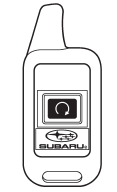
NOTE
All vehicle doors, the engine hood and trunk / rear gate must be closed prior to activating the remote engine start system. Any open entry point will prevent starting or cause the system to shut down.
The remote engine start function is activated by pressing the “ ”
button twice within 3 seconds on your remote engine start transmitter. Upon successful
activation the remote start confirming transmitter button will flash once* and the
vehicle will honk the horn and flash the side marker lights, tail lights and front
position lights once. The system will check certain preconditions before starting,
and if all safety parameters are correct, the engine will start within 5 seconds.
Upon successful engine start, the remote start confirmation transmitter button will
flash twice every 5 seconds* and the vehicle will honk the horn and flash the side
marker lights, tail lights and the front position lights once, then the lights will
illuminate and remain illuminated, indicating that the engine is running. While
the vehicle is operating via the remote engine start function, the power window
features will be disabled. Also, the system has a timer and will shut down after
15 minutes if you do not operate the vehicle. Press and hold the “
”
button twice within 3 seconds on your remote engine start transmitter. Upon successful
activation the remote start confirming transmitter button will flash once* and the
vehicle will honk the horn and flash the side marker lights, tail lights and front
position lights once. The system will check certain preconditions before starting,
and if all safety parameters are correct, the engine will start within 5 seconds.
Upon successful engine start, the remote start confirmation transmitter button will
flash twice every 5 seconds* and the vehicle will honk the horn and flash the side
marker lights, tail lights and the front position lights once, then the lights will
illuminate and remain illuminated, indicating that the engine is running. While
the vehicle is operating via the remote engine start function, the power window
features will be disabled. Also, the system has a timer and will shut down after
15 minutes if you do not operate the vehicle. Press and hold the “ ”
button for 2 seconds to turn the engine off. The remote start confirmation transmitter
button will flash three times* indicating that the engine has shut down. If the
starter cranks but does not start or starts and stalls, the remote engine start
system will power off and then attempt to start the engine an additional three times
unless the remote engine start system determines that a vehicle malfunction is preventing
the system from starting. If the engine does not start after additional attempts,
the remote engine start system will abort and return to a non-activate state.
”
button for 2 seconds to turn the engine off. The remote start confirmation transmitter
button will flash three times* indicating that the engine has shut down. If the
starter cranks but does not start or starts and stalls, the remote engine start
system will power off and then attempt to start the engine an additional three times
unless the remote engine start system determines that a vehicle malfunction is preventing
the system from starting. If the engine does not start after additional attempts,
the remote engine start system will abort and return to a non-activate state.
*: Provided that the remote engine start transmitter is within the operating range of the system.
Remote start safety features
For safety and security reasons, the system will fail to start and honk the horn twice or shut down the engine during remote start operation if any of the following occur:
● Any of the doors or the trunk / rear gate are open / opened (*the vehicle’s
horn will honk six times and the side marker lights, tail lights and the front position
lights will flash six times indicating that a vehicle door or trunk / rear gate
was open when the remote engine start system was activated).
● The brake pedal is depressed
● The key was already in the ignition switch
● The engine hood is opened
● The remote start system “Service mode” is engaged
● The vehicle’s engine idle speed has reached a level over 3,500 RPM
● The alarm is triggered by opening a door or the rear gate.
● The select lever is not in the “P” position (AT and CVT models) In addition to
the items above, if the vehicle’s engine management system determines there is a
safety risk due to a vehicle related problem, the vehicle will shut down and the
vehicle’s horn will honk three times.
NOTE
● If the alarm system is armed at the time of remote engine start activation (the security indicator light on the combination meter is flashing), the alarm system will remain armed throughout the remote start run cycle.
● If the alarm system is disarmed at the time of remote engine start activation (the security indicator light on the combination meter is not flashing), the alarm system will remain disarmed throughout the remote start run cycle.
Entering the vehicle while it is running via remote start
1. Unlock the vehicle doors using the remote keyless entry system. If the vehicle’s
doors are unlocked manually using the key, the vehicle’s alarm system will trigger
(if the alarm system is armed prior to activating the remote engine start system)
and the engine will turn off. Inserting the key into the ignition switch and turning
it to the “ON” position or pressing the unlock button “ ”
on the remote keyless entry transmitter will disarm the alarm system. Refer to “Alarm
system” F2-15.
”
on the remote keyless entry transmitter will disarm the alarm system. Refer to “Alarm
system” F2-15.
2. Enter the vehicle.
3. The engine will shut down when any door or trunk/rear gate is opened.
4. Insert the key into the ignition switch and turn to the “START” position to restart the engine.
Remote start confirmation transmitter feature
Your remote engine start transmitter is equipped with a unique bidirectional confirmation feature. This feature will allow the transmitter’s backlit button to display the status of the system under the condition that the vehicle and transmitter are within the operational range of the system. Typical transmitter button flash sequences are outlined in the following chart.
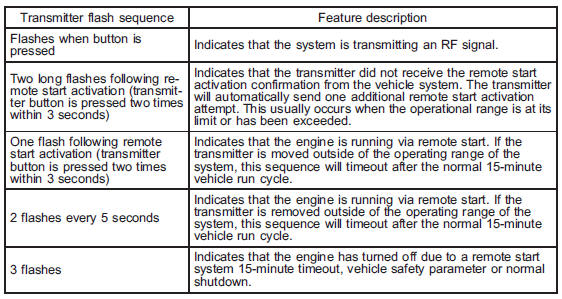
Entering the vehicle following remote engine start shutdown
An alarm trigger may occur if the vehicle is opened by the remote keyless entry transmitter within a few seconds immediately following remote engine start shutdown.
Pre-heating or pre-cooling the interior of the vehicle
Models with automatic climate control system:
After the system starts the engine, the automatic climate control system will activate the “FULL AUTO” mode and heat or cool the interior to the predetermined median (room) temperature. No presetting of controls is necessary.
Models with manual climate control system:
Before exiting the vehicle, set the temperature controls to the desired setting and operation. After the system starts the engine, the heater or air conditioning will activate and heat or cool the interior to your setting.
Service mode
In service mode, the remote engine start function is temporarily disabled to prevent the system from unexpectedly starting the engine while being serviced.
To engage or disengage service mode:
1. Enter the vehicle and close all vehicle doors and the trunk/rear gate.
2. Verify that the select lever is in the “P” position (AT and CVT models)
3. Depress and hold the brake pedal
4. Turn the ignition switch to the “ON” position
5. Press and release the remote engine start transmitter “ ”
button three times. The system will honk the vehicle’s horn each time the button
is pressed.
”
button three times. The system will honk the vehicle’s horn each time the button
is pressed.
6. The system will pause for 1 second then honk the vehicle’s horn three times to
indicate that the service mode has been engaged or honk one time to indicate that
the service mode has been disengaged.
NOTE
When taking your vehicle in for service, it is recommended that you inform the service personnel that your vehicle is equipped with a remote engine start system.
Remote transmitter program
New transmitters can be programmed to the remote engine start system in the event that a transmitter is lost, stolen, damaged or additional transmitters are desired (the system will accept up to eight transmitters). New remote engine start transmitters can be programmed according to the following procedure.
1. Open the driver’s door (the driver’s door must remain opened throughout the
entire process).
2. Depress and hold the brake pedal.
3. Turn the ignition switch to “ON” then “LOCK”, back to “ON” then “LOCK”, then
back to “ON” again and leave the ignition “ON” throughout the programming process.
4. The system will flash the side marker lights, tail lights and front position
lights and honk the horn three times, indicating that the system has entered the
transmitter learn mode.
5. Press and release the “ ” button on the transmitter that you want to program.
6. The system will flash the side marker lights, tail lights and front position
lights and honk the horn one time, indicating that the system has learned the transmitter.
Upon successful programming, the remote start confirmation transmitter button will
flash one time.
7. Repeat step 5 for any additional transmitters (the system will accept up to eight
transmitters).
8. The system will exit the transmitter learn mode if the key is turned to the “LOCK”
position, the door is closed or after 2 minutes.
System maintenance
NOTE
In the event that the vehicle’s battery is replaced, discharged or disconnected, it will be necessary to start the vehicle a minimum of one time using the key prior to activating the remote engine start system. This is required to allow the vehicle electronic systems to resynchronize.
Changing the batteries
CAUTION
● Do not let dust, oil or water get on or in the remote engine start transmitter when replacing the battery.
● Be careful not to damage the printed circuit board in the remote engine start transmitter when replacing the battery.
● Be careful not to allow children to touch the battery and any removed parts; children could swallow them.
● There is a danger of explosion if an incorrect replacement battery is used. Replace only with the same or equivalent type of battery.
● Batteries should not be exposed to excessive heat such as sunshine, fire or the like.
The two 3-volt lithium batteries (model CR-2032) supplied in your remote engine start transmitter should last approximately one year, depending on usage. When the batteries begin to weaken, you will notice a decrease in range (distance from the vehicle that your remote control operates). Follow the instructions below to change the remote engine start transmitter batteries.
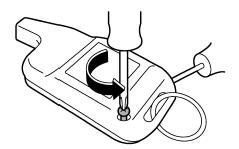
1. Remove the small Phillips type screw located on the back side lower left corner of the transmitter.
2. Carefully pry the remote engine start transmitter halves apart using a small flathead screwdriver.
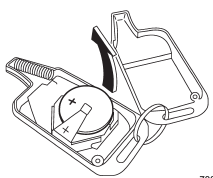
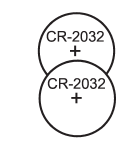
3. Remove the circuit board from the bottom half of the case and remove the batteries and replace with new ones. Be sure to observe the (+) sign on the old batteries before removing them to ensure that the new batteries are inserted properly (battery “+” should be pointed away from the transmitter circuit board on both batteries).
4. Carefully snap the case halves back together, reinstall the Phillips type screw and test the remote engine start system.
NOTE
● This device complies with Part 15 of the FCC Rules and with RSS-210 of Industry Canada. Operation is subject to the following two conditions: (1) This device may not cause harmful interference, and (2) this device must accept any interference received, including interference that may cause undesired operation. Changes or modifications not expressly approved by the party responsible for compliance could void the user’s authority to operate the equipment and void warranty.
● To comply with the FCC RF exposure compliance requirements, no change to the antenna or the device is permitted. Any change to the antenna or the device could result in the device exceeding the RF exposure requirements and void user’s authority to operate the device.


